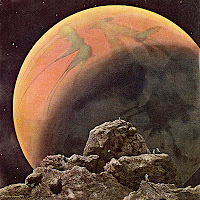
This, the third and last part of this strange account, is a follow up to an earlier jot.
January 15th. For the sake of those who, in spite of my gloomy experience on the whole, wish to make this voyage too, I should like to make the following observations on the equipment required for the expedition. A large quantity of provisions, as for an Arctic or Antarctic expedition for many years is a first requirement. It is quite easy to keep the provisions here owing to the permanently low temperature in the ground. If economically used, sufficient water can be obtained by melting hoar-frost.
Continue reading








